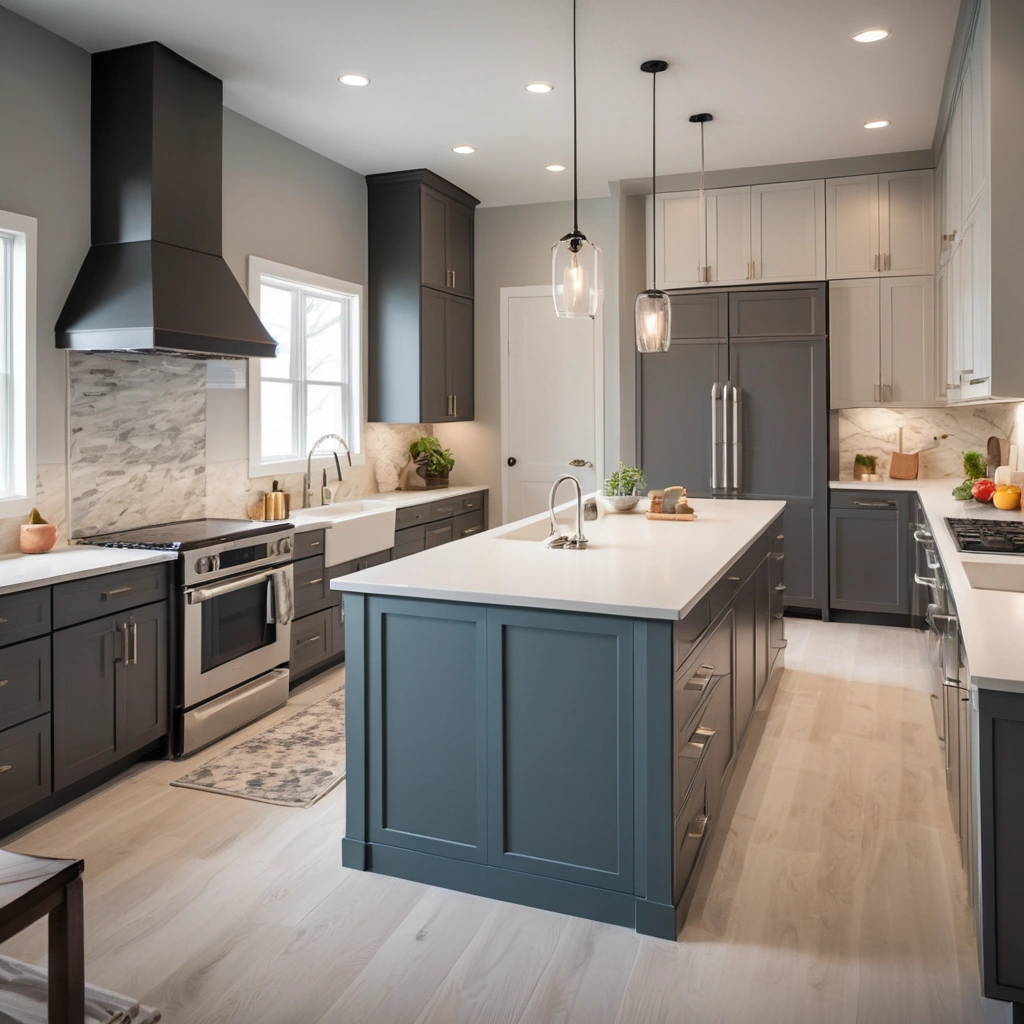Kitchen and Bathroom Remodeling Trends and Planning for 2025: A Step-by-Step Guide
Introduction: Remodeling for the Future
The kitchen and bathroom: two spaces intrinsically linked to our daily lives, yet often overlooked in terms of design and functionality. As we approach 2025, the landscape of home renovation is shifting, driven by technological advancements, a growing emphasis on sustainability, and evolving aesthetic preferences. This comprehensive guide provides homeowners with a roadmap to navigate the complexities of kitchen and bathroom remodeling, ensuring a seamless and rewarding transformation. Whether you’re envisioning a sleek, modern kitchen equipped with smart appliances or a spa-like bathroom retreat, this article will equip you with the knowledge and tools to bring your vision to life.
Looking ahead to kitchen remodel 2025 trends, we see a confluence of factors influencing design choices. The desire for open-concept living continues to drive kitchen layouts, with an emphasis on maximizing natural light and creating seamless transitions to adjacent living spaces. Expect to see a rise in the popularity of minimalist aesthetics, clean lines, and integrated appliances that create a sense of spaciousness and calm. Simultaneously, homeowners are increasingly prioritizing functionality and storage solutions, seeking innovative ways to optimize every square inch of their kitchens.
This includes features like pull-out pantries, hidden spice racks, and customized drawer organizers, reflecting a shift towards personalized and highly efficient kitchen spaces. In the realm of bathroom renovation trends, the focus is shifting towards creating spa-like sanctuaries that promote relaxation and well-being. Modern bathroom design increasingly incorporates elements of biophilic design, such as indoor plants, natural stone accents, and water features, to create a connection with nature. Smart home technology is also playing a significant role, with features like smart showers, heated floors, and voice-activated lighting systems enhancing the overall bathroom experience.
Accessibility is another key consideration, with universal design principles being integrated to ensure that bathrooms are safe and comfortable for people of all ages and abilities. Expect to see a growing demand for walk-in showers, grab bars, and adjustable-height vanities as homeowners prioritize long-term functionality and comfort. Before embarking on any remodeling project, understanding the remodeling budget is paramount. DIY kitchen remodel projects can offer significant cost savings, but require careful planning and execution. Conversely, larger-scale renovations involving structural changes or extensive plumbing and electrical work will necessitate the expertise of qualified professionals. Regardless of the scope, it’s crucial to establish a realistic budget that accounts for material costs, labor expenses, permits, and unexpected contingencies. By carefully considering your priorities and exploring various financing options, you can ensure that your kitchen or bathroom remodel remains within your financial reach and delivers lasting value to your home.
Design Trends: Sustainability, Smart Tech, and Biophilic Design
Emerging design trends are reshaping kitchens and bathrooms into spaces that are not only aesthetically pleasing but also highly functional and environmentally conscious. Sustainable materials, once niche, are now at the forefront of kitchen remodel 2025 and bathroom renovation trends. Bamboo cabinetry, with its rapid renewability, recycled glass countertops offering unique visual appeal, and reclaimed wood flooring adding character and history are all gaining traction. This shift reflects a growing commitment to environmental responsibility, aligning with a broader societal push for sustainable practices in home improvement.
Smart home integration continues its upward trajectory, transforming kitchens and bathrooms into intelligent environments. Voice-activated faucets that respond to touchless commands, smart refrigerators capable of inventory management and meal planning, and automated lighting systems that adjust to time of day and user preferences are no longer futuristic fantasies but readily available features. These technologies enhance convenience and efficiency, contributing to a more seamless and enjoyable daily experience. Planning a smart home kitchen or modern bathroom design requires careful consideration of electrical infrastructure and compatibility between devices to maximize functionality and avoid costly retrofitting.
Color palettes are evolving, moving away from stark minimalism towards warmer, earthier tones that evoke a sense of comfort and tranquility. Think muted greens, soft browns, and creamy whites, often complemented by pops of bold accent colors in accessories or artwork. Biophilic design principles are also increasingly influential, with homeowners seeking to incorporate natural elements like plants, natural light, and water features to create calming and restorative spaces. Integrating these elements can be a relatively affordable DIY kitchen remodel project, involving strategically placed indoor plants or even a small indoor herb garden.
When assessing your remodeling budget, remember to factor in these design choices as they contribute significantly to the overall ambiance. The rise of personalized spaces is another key trend. Homeowners are increasingly tailoring their kitchens and bathrooms to meet their specific needs and preferences, creating unique and highly functional areas. This might involve a dedicated coffee station with a built-in espresso machine and storage for beans and mugs, or a meditation nook within the bathroom, complete with soft lighting, comfortable seating, and calming aromatherapy diffusers. Considering bathroom design ideas that cater to individual routines and preferences can significantly enhance the usability and enjoyment of these spaces. Understanding kitchen renovation cost and bathroom remodeling tips related to personalized features can help in making informed decisions during the planning phase.
Budgeting Strategies: From Materials to Labor
Budgeting is crucial for a successful remodel, acting as the financial roadmap for your vision. Begin by meticulously defining the scope of your project and prioritizing needs versus wants. A comprehensive kitchen remodel 2025, incorporating the latest smart home kitchen technology and sustainable kitchen design elements, can range from $25,000 to upwards of $100,000, influenced by factors such as kitchen size, choice of materials, and the complexity of the design. Bathroom renovations, reflecting modern bathroom design and incorporating current bathroom renovation trends, typically fall within the $15,000 to $50,000 range.
Accurately assessing these initial costs is the first step in establishing a realistic remodeling budget. Material selection significantly impacts the overall remodeling budget. High-end choices like custom cabinetry or imported tile can quickly inflate costs. For example, quartz countertops, a popular choice for their durability and aesthetics, range from $50 to $100 per square foot installed, while premium granite or marble can easily exceed $150 per square foot. Similarly, plumbing fixtures, appliances, and lighting selections should be carefully considered.
Exploring sustainable and cost-effective alternatives, such as reclaimed materials or energy-efficient appliances, can help manage expenses without compromising on style or functionality. Thorough research and comparison shopping are essential for making informed decisions about material choices. Labor costs represent a substantial portion of the kitchen renovation cost and bathroom remodeling tips often emphasize strategies to manage them. These costs are heavily influenced by location, contractor experience, and the complexity of the project. Obtain at least three detailed quotes from qualified, licensed, and insured contractors, carefully scrutinizing each proposal for inclusions and exclusions.
Verify references and review portfolios to assess the quality of their work. A contingency fund, typically 10-15% of the total budget, is crucial to cover unexpected expenses, such as hidden plumbing issues or unforeseen structural repairs. Effective communication with your contractor and meticulous project management can help minimize cost overruns and ensure a smooth renovation process. For homeowners inclined towards DIY projects, a DIY kitchen remodel or elements of a bathroom renovation can offer significant savings on labor costs.
However, it’s essential to realistically assess your skills and experience before undertaking complex tasks such as plumbing or electrical work. Mistakes in these areas can be costly and even dangerous. Focus on projects that align with your capabilities, such as painting, tiling, or installing simpler fixtures. Remember to research building codes and obtain necessary permits to ensure compliance. Investing in quality tools and materials is also crucial for achieving professional-looking results. Consider taking workshops or online courses to enhance your skills and knowledge.
Finally, explore financing options and potential tax credits to offset the cost of your remodel. Home equity loans, personal loans, and credit cards are common financing options, each with its own advantages and disadvantages. Research available tax credits for energy-efficient upgrades, such as installing Energy Star appliances or improving insulation. These incentives can significantly reduce the overall cost of your project and contribute to a more sustainable home. Thoughtful financial planning and diligent research are key to achieving your dream kitchen or bathroom without exceeding your budget.
Project Planning: Timeline, Contractors, and Permits
Effective project planning is essential for any successful kitchen remodel 2025 or bathroom renovation trends project. Begin by creating a detailed timeline, outlining each stage of the remodel, from initial design to demolition and final installation. This timeline should not only include the major phases but also allocate time for unexpected delays, material procurement, and contractor availability. Contractor selection is a critical step; thoroughly check references, meticulously review portfolios showcasing similar projects, and absolutely ensure the contractor is licensed and insured to operate in your jurisdiction.
Obtain all necessary permits from your local building department before commencing any work; failure to do so can result in costly fines and project shutdowns. Design considerations must include optimizing layout for functionality and flow, incorporating accessibility features for aging in place, and maximizing storage solutions to meet evolving needs. In the kitchen, carefully consider the work triangle (sink, stove, refrigerator) and island placement to enhance efficiency. In the bathroom, prioritize ventilation to prevent mold and moisture issues, a key element in modern bathroom design.
Common pitfalls to avoid include underestimating the remodeling budget, failing to obtain necessary permits, and neglecting comprehensive planning. Beyond the fundamental steps, a deep dive into material selection is crucial for both aesthetics and longevity. For a sustainable kitchen design, explore options like reclaimed wood, recycled glass, and low-VOC paints. When considering your kitchen renovation cost, remember that investing in high-quality, durable materials can save money in the long run by reducing the need for frequent repairs or replacements.
Similarly, bathroom design ideas should encompass water-efficient fixtures and durable tiling to withstand moisture and wear. Don’t underestimate the impact of lighting; well-placed lighting can transform a space, enhancing both its functionality and ambiance. Consider incorporating smart home kitchen technology, such as voice-activated lighting and temperature controls, for added convenience and energy efficiency. For those considering a DIY kitchen remodel or any home improvement project, meticulous planning becomes even more paramount. Accurately assess your skill level and realistically evaluate the time commitment involved.
A seemingly simple task can quickly become overwhelming without the necessary expertise. Leverage online resources, tutorials, and workshops to expand your knowledge base. When undertaking a bathroom remodeling tips project, prioritize safety; always disconnect power and water supplies before starting any demolition work. Furthermore, consider investing in professional consultations for critical aspects such as plumbing and electrical work to ensure compliance with building codes and prevent potential hazards. Remember, a well-planned and executed DIY project can be incredibly rewarding, but it requires careful preparation and a realistic assessment of your capabilities.
Step-by-Step Remodeling Process: Kitchen and Bathroom
The kitchen remodel process typically involves a structured sequence: demolition of existing structures, followed by essential plumbing and electrical work to accommodate new layouts and appliances. Cabinet installation forms the backbone of the kitchen’s functionality, succeeded by countertop installation, which significantly impacts the aesthetic and usability of the space. Backsplash installation adds a layer of design and protection, while appliance installation integrates modern conveniences. Finally, flooring ties the room together, offering durability and style. Similarly, the bathroom remodel process commences with demolition, leading into plumbing and electrical adjustments.
Framing is often necessary to redefine the space, followed by crucial waterproofing to prevent moisture damage. Tile installation creates a waterproof and visually appealing surface, and fixture installation (toilet, sink, shower/tub) brings functionality to the forefront. Painting provides the finishing touch, unifying the design elements. For both spaces, ensuring proper ventilation and lighting is paramount for comfort and safety. DIY kitchen remodel projects can save on labor costs, but require careful planning and execution, especially when dealing with plumbing and electrical systems.
Bathroom renovation trends in 2025 emphasize walk-in showers and smart toilets. Case studies consistently demonstrate that strategic kitchen and bathroom remodels yield substantial returns on investment, significantly increasing home value. A well-designed kitchen, incorporating elements of sustainable kitchen design and smart home kitchen technology, can transform cooking habits and foster greater family interaction. Imagine a kitchen featuring energy-efficient appliances, voice-controlled lighting, and a central island designed for both meal preparation and social gatherings. Conversely, a spa-like bathroom, reflecting modern bathroom design principles, can dramatically enhance relaxation and well-being.
Consider incorporating features such as heated flooring, a soaking tub, and a rainfall showerhead to create a personal oasis. Thoughtful bathroom design ideas can transform a cramped space into a luxurious retreat, improving daily routines and overall quality of life. To ensure a successful outcome, homeowners must carefully consider design trends, budget effectively, and plan meticulously. Understanding the kitchen renovation cost and remodeling budget is crucial for making informed decisions about materials and labor. For example, opting for cost-effective yet stylish materials like laminate flooring or prefabricated cabinets can help keep the project within budget. Remember that bathroom remodeling tips often include prioritizing essential upgrades, such as plumbing and electrical systems, before focusing on cosmetic enhancements. By prioritizing these key aspects, homeowners can transform their kitchens and bathrooms into spaces that are not only beautiful and functional but also add significant value to their homes. A kitchen remodel 2025 should include energy-efficient appliances to save money and reduce environmental impact.


